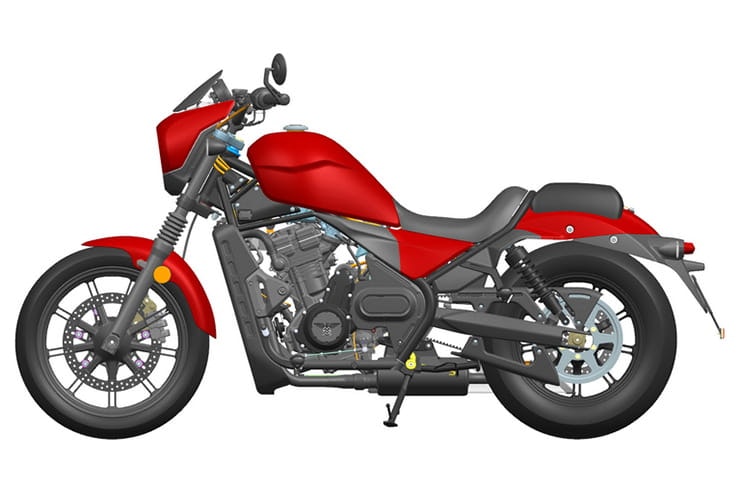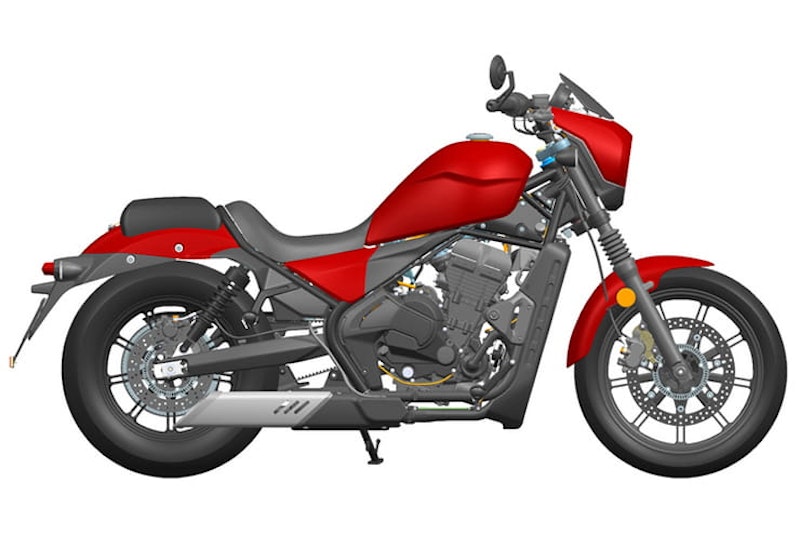Moto Morini 650 cruiser on the way
By Ben Purvis
Motorcycle Journalist
30.01.2023
We’re getting on for five years since Moto Morini passed into the hands of China’s Zhongneng Vehicle Group and after a slow start the company is starting to ramp up its production and expand its model range. We’ve already reported on plans to revive the 1187cc ‘CorsaCorta’ V-twin in a big X-Cape 1200 adventure bike and now Morini is looking at the cruiser market with designs for a 650cc twin that will rival the likes of Kawasaki’s Vulcan S.
Design registrations from Morini’s parent company show the upcoming cruiser model in detail, revealing that it uses the same engine as the existing 6 ½ Seiemmezzo and X-Cape 650, and promising the same mix of affordability and decent build and components. Both the existing 650cc Morini models undercut their direct rivals from Japan and Europe while including elements like Brembo brakes that you might not expect to find in the sub-£7000 market that they inhabit.
The cruiser’s engine is, like its sister models, sourced from CFMoto and heavily influenced by the long-lived Kawasaki 650 parallel twin that dates back to the ER-6 and remains in bikes like the Vulcan S and Z650. With 60hp its power exactly matches the £7449 Vulcan S, which is clearly the Morini’s closest competitor, although the Seiemmezzo and X-Cape both need more revs to hit that number than the Vulcan – 8,250rpm for the Morinis, 7,500rpm for the Kawasaki – and lag behind on torque with a peak of 40 lb-ft at 7,000rpm. The Kawasaki manages 46 lb-ft at only 6,600rpm. Of course it’s not certain at this stage whether the upcoming Morini cruiser will have exactly the same state of tune as the other models, so those numbers may change.
The existing Seiemmezzo and X-Cape share a chassis design but the cruiser has a completely different frame. Funnily enough, the existing Morini models’ frame is much closer to the Kawasaki Vulcan’s than the cruiser, which adopts a very conventional double-cradle design. Its swingarm is new, too, made of cast alloy and supported by twin rear shocks for a traditional cruiser style, while the front end uses right-way-up forks with gaiters to add a retro touch.
Unlike the other models in the Morini range, the cruiser features a belt final drive. Cleaner, quieter and less maintenance-intensive than a chain, belts have long been favoured by cruiser customers, so it’s a change that makes sense.
The styling doesn’t try to break any norms, either, with proportions and shapes that fit into expectations from the class, even if the parallel twin engine and the presence of a radiator go against the tradition of air-cooled V-twin cruisers. Alloy wheels rather than wires add touch of modernity, although it would be no surprise if wires are offered as an option. The small nose cowl surrounds a conventional, round headlight – and again it’s easy to imagine that a second version without the cowling would be a no-brainer as a way to expand the range.
The riding position features the expected ultra-low seat height and forward-mounted foot controls, but stops short of ape-hangers. A single, circular instrument – with an analogue speedo above a small digital read-out – sits atop the wide, lowish bars.
When it comes to a name, Morini current refers to the bike only as ‘P16’ but can look to its past to choose a catchier name. In the 1980s the firm offered two cruiser models – the Excalibur and New York – and either title could be revived for the new machine. Both those older models had styling that erred towards ‘chopper’ rather than cruiser, with extremely long forks and high-set headstocks creating a rather unbalanced look that was emphasised by the small V-twin engine they both used. The Excalibur, in particular, had caricatured styling that, if replicated today on a Chinese-made bike (which is what the latest generation of Morinis are) would be roundly mocked, so the decision not to lean too heavily on the company’s heritage is a good one.
Although only shown in drawings so far, it’s likely that the real Morini cruiser will appear in the metal later this year.
Share on social media:

